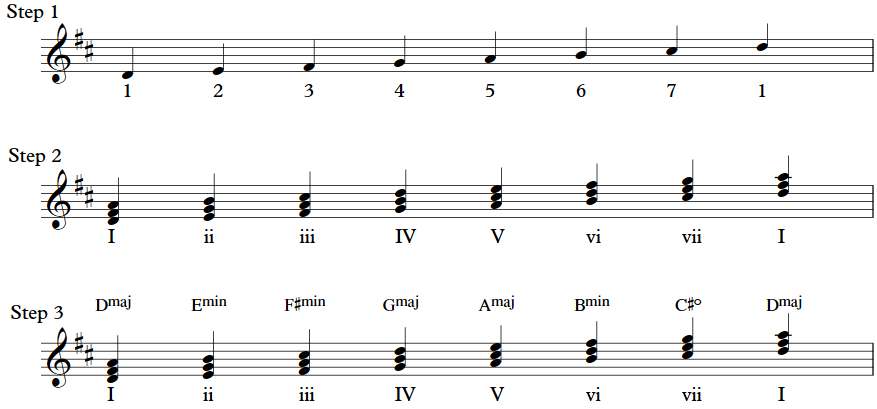Diatonic Chords and Rock Piano

When learning to play rock piano one of the most important skills you can acquire is learning to play all of your major triads (and later minor triads) in each of the 12 keys. The major and minor triads that can be found within a particular key are referred to as the “diatonic” triads. This is a term that you may have heard before but perhaps not fully understood. In this article, we’ll do three things:
- make sense of the term diatonic;
- I’ll show you a great exercise that you can use to practice this diatonic major/minor triad concept; and,
- I’ll show you a couple of the most popular rock tunes of all-time that are built almost entirely on these triad exercises.
Diatonic
This term often confuses students but is actually quite easy to understand once explained. Think of any major scale (for example, D major). The notes contained in that D major scale are diatonic to D major (ie, the notes D, E, F#, G, A, B, C#). The notes not contained in the scale (ie, the notes outside of the key, meaning D#, F, G#, A#, and C) are called chromatic. That’s it. Pretty simple, right?
Diatonic Chords
Diatonic chords refer to the chords which can be created within a key by following a few easy steps.
Step #1: Number each note of the scale in order.
Step #2: Stack 3rds on each note of the scale to build triads (3-note chords).
Step #3: Identify and play (and memorize) these diatonic chords.
Notice anything different about Steps 2 and 3 above? We switched from using regular numbers to Roman numerals when we labeled the diatonic chords. In music theory, we talk about individual notes by using regular numbers and chords by using Roman numerals. We also talk about chords by their Roman numeral name. So, if someone asks you to play a IV chord in the key of D, you would play a G major chord. (We also use upper and lower-case for major and minor, respectively).
Diatonic Chord Exercise
Here’s a great exercise that gets you playing through many (not all) of the diatonic chords in a given key. In your left hand you will simply play a descending major scale one note at a time. In your right hand you will play various inversions of the diatonic chords. Check it out!
This exercise gets you playing through many of the diatonic chords AND the various inversions of those chords. If this chord progression sounds familiar it’s because it’s the same chord progression that Billy Joel uses in his hit song “Piano Man” (although he plays it in the key of C major). This progression is also very similar to the chord progression used for the intro of Elton John’s song “Goodbye Yellow Brick Road.” It’s an often-used progression in rock music and an excellent exercise for learning your diatonic chords and their inversions. In order to get the most bang for your buck, be sure to practice this progression in a few different keys and use your metronome!


